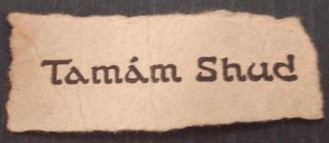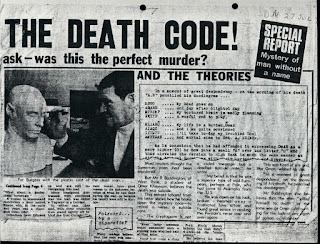The recent and rancorous case of Russian spies (in fact double-agents) poisoned in the United Kingdom stirs recollections of one of the most mysterious cases of all, that of the so-called Somerton Man, who was found dead on a beach in Adelaide, Australia, in 1948. It is widely believed - though this is far from established - to be an instance of a spy murdered by poison in the context of Russian/Western intrigues. As of this date, May 2018, it remains entirely unsolved with the identity of the deceased, precise cause of death and background to the incident all perfectly opaque. Many formidable minds have tackled the mystery to no avail and it is not likely to be resolved any time soon.
The body of an unidentified man was found propped against the retaining wall on Somerton beach, Adelaide, at approximately 6.45am, 1st December 1948. The man had no wallet and all the name tags of his clothes had been removed. There was no sign of violence or of a struggle and no obvious cause of death. He was a strong, athletic man with strongly developed legs but hands showing no signs of manual labour. His nationality is unknown but many reports - though these are questionable - described him as having an eastern European appearance. He was carrying cigarettes, (with a half-smoked cigarette resting on his collar and another cigarette behind his ear), a comb, an unused train ticket and a bus ticket. The first police reports suspected suicide.
All subsequent attempts to identify him failed. He matched no missing person, either in Australia, Britain, the United States or Europe. The police made an extensive search. An autopsy determined that he had almost certainly been poisoned, but the poison had dissolved and could not be ascertained. (An inquest decades later concluded it was "probably" digitalis.) The mystery deepened further when he was connected to an unclaimed suit case at the bus station where he had bought the ticket, and even further when a more extensive examination of his clothing discovered a hidden 'fob' pocket in which there was a slip of paper bearing the words 'Tamam Shud'. This latter item became the distinguishing point of the case. Thus indeed is the unidentified man sometimes named 'Tamam Shud' since his real name is unknown.
It was then established that 'Tamam Shud' were the concluding (Persian) words of Omar Khyyam's collection of quatrains, the Rubaiyat. The words mean 'The End' or 'It is Finished'. This again might suggest suicide, except some evidence in the case points in other directions. A common theory - almost entirely conjecture - is that the man in question was a spy involved in post-war subterfuge possibly involving British rocket and weapon tests at a South Australian air base and that secrets were being passed via coded messages using the Rubaiyat. A web of evidence suggests there is more to the case than meets the eye, but the whole matter is far from clear. It became even more opaque when the copy of the Rubaiyat from which the words 'Tamam Shud' had been torn was handed to the police. The book had been tossed into the back seat of a car parked at Somerton beach. A code (of sorts) was found lightly pencilled in the back. It has never been 'cracked'. It is as follows:

There was, moreover, a phone number pencilled in the back of the book as well, and it was found to belong to a woman who lived less than a mile from where the man was found. The woman in question told police she knew nothing of the man, but strangely she did admit to having given a copy of the Rubaiyat to a lover years before. This lead went cold when that lover was found to be alive and well and living in Sydney and was able to produce the said copy of the Rubaiyat. All the same, the fact remains that the deceased can be positively connected to the woman by her phone number. Why did a man who died on a beach less than a mile from her house have her phone number in a discarded copy of the Rubaiyat along with what appears to be a sequence of coded letters?
This is the crux of it and such questions make it a tantalizing mystery. It is not our purpose here to rehearse all the details of the case, unusually fascinating though they are. The full details and lists of all the sundry 'clues' are commonly available at numerous websites, in the relevant wikipedia articles as well is in the following short video:
This is the crux of it and such questions make it a tantalizing mystery. It is not our purpose here to rehearse all the details of the case, unusually fascinating though they are. The full details and lists of all the sundry 'clues' are commonly available at numerous websites, in the relevant wikipedia articles as well is in the following short video:
* * *
Instead, in this post we merely want to give some credit to an early but largely forgotten theory - that of a Mr Bobbington - regarding the meaning of the 'coded' letters cited above. Many ingenious theories have been formulated to explain the death and many solutions to the code - some of them quite fanciful - have been proposed. Speculation has been so rife it can be hard, indeed, to find a sober point of view. Since there are so few certainties in the case it has become awash with wild theories. The nature of the 'code' is no exception. The best code crackers in the world have not been able to shed much light upon it: this invites cranks and conspiracy theorists peddling all manner of bizarre proposals.
The Bobbington theory, however, is altogether sedate and has numerous virtues. It is worth revisiting. It was offered in the years following the discovery of the deceased but has since been obscured by a host of more flamboyant proposals. Mr Bobbington is described in an article in the Daily Mail newspaper from shortly after the case came to wide public interest as "an expert on Omar Khyyam..." who believed that the Rubaiyat itself provided the answers to the mystery. This strikes the present writer as not an unreasonable likelihood, and since no other theories have proved sustainable Mr Bobbington's solution deserves some fresh attention.
Here is the relevant newspaper article in which the Bobbington theory first appeared:
The Bobbington theory, however, is altogether sedate and has numerous virtues. It is worth revisiting. It was offered in the years following the discovery of the deceased but has since been obscured by a host of more flamboyant proposals. Mr Bobbington is described in an article in the Daily Mail newspaper from shortly after the case came to wide public interest as "an expert on Omar Khyyam..." who believed that the Rubaiyat itself provided the answers to the mystery. This strikes the present writer as not an unreasonable likelihood, and since no other theories have proved sustainable Mr Bobbington's solution deserves some fresh attention.
Here is the relevant newspaper article in which the Bobbington theory first appeared:
Mr Bobbington favours a suicide scenario rather than something more nefarious as the cause of death. In fact, he proposes that the Somerton Man may have "willed himself to death" in the same manner as the pessimistic Persian poet. The arguments for suicide are less sensational than the arguments for espionage and murder but are substantial. As already noted, the first police reports after the body was discovered suggested it was a case of suicide. The crux of a suicide scenario is that the Somerton Man was yet another lover of the woman who lived nearby the beach and that she had given him a copy of the Rubaiyat as well. (The theme of Omar Khyyam, let us recall, is life is short and sad, so live well and enjoy.) In this scenario the Somerton Man arrived in Adelaide to visit her but found her living with another man. Heartbroken, he ended it all on Somerton Beach.
The one thing about which expert codebreakers agree concerning the mysterious letters in the back of the Rubaiyat is that they are almost certainly acrostics, which is to say each letter is the first letter of a word. They are not encryptions as such. They do not conform to the patterns of any known type of code. Too few proposed solutions take account of this. Mr Bobbington, however, proposes - not unreasonably - that the letters are mnemonic acrostics for a verse (a rubaiyat) that the dead man himself composed as a type of suicide note. It is a proposal that has the virtue of at least being contextual. There is no need to introduce Russian spies and British rockets; we merely need to note that the letters are found at the back of a copy of Omar Khayyam and so to consider it likely that the letters have to do with the poems of the book. It was very common, in fact, for enthusiasts of Omar Khyyam to invent new verses - it is a feature of the genre - and this is what Mr Bobbington (a Khyyam expert who was fully aware of this fact) proposes the heartbroken lover to have done. He then provides a possible reconstruction of the new verse, made in Khyyam's manner:
My road goes on
And day after blighted day
My tortured brain is madly planning
A woeful end to play
My life is a burden, Omar
And I am quite convinced
And day after blighted day
My tortured brain is madly planning
A woeful end to play
My life is a burden, Omar
And I am quite convinced
I'II take today my troubled soul
And mortal sins to God, A. B.
And mortal sins to God, A. B.
One of the neat features of the Bobbington proposal is that he explains the 'x' that appears above the letter O in the 'code'. He concludes that it stands for 'Omar', the legendary poet himself. Assuredly, there is - and will ever remain - too little to go on for this to be confirmed, but it does provide a good example of what the letters might mean in the context. Modern readers can hardly take account of just what a following, and what place in romance, the Rubaiyat (popularized through Fitzgerald's translation) had in people's hearts back then. No one reads Omar Khyyam anymore. It is therefore hard to give a proper account of its significance in this case. When readers investigate the case further, however - if they are willing to put aside the more salacious espionage scenarios - they will find that the Bobbington theory is as good a solution as has yet been proposed and indeed is better than most.
Yours, Harper McAlpine Black





I’m loving everything about this post
ReplyDelete